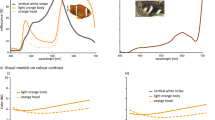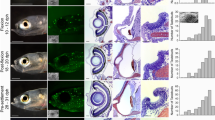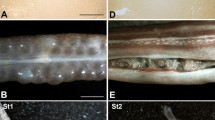Abstract
Unlike most marine teleosts, the coral reef-dwelling spiny damsel, Acanthochromis polyacanthus, lacks a pelagic larva dispersal phase and represents one of few examples of self recruitment onto a natal reef by a marine teleost immediately after hatching. Benthic eggs are protected by the parents, and upon hatching the young remain under parental care for several months. Visual morphogenesis of spiny damsel embryos and juveniles was examined to evaluate the potential visual capabilities of the young after emergence onto the reef. The optic primordia were visible in the embryo as hollow spheres of undifferentiated neuroblasts 2 days after fertilization (daf). Visual morphogenesis proceeded rapidly thereafter in the embryo such that at hatching (between 10 and 12 daf) gross visual morphology was consistent with that reported in the majority of juvenile marine teleosts, reflecting direct development of the retina of the spiny damsel within the egg. At hatching, the outer nuclear layer comprised 2 classes of photoreceptors; cones and rods. Tangential sections of the retina revealed a square cone mosaic in which 4 double cones surrounded a single cone. This arrangement remained unchanged in all later life history intervals examined. Absolute eye size was large compared to larvae of marine pelagic spawners. Eye and lens diameters increased from 0.69 and 0.23 mm, respectively, on the day of hatching (12 daf), to 3.77 and 1.52 mm, respectively, in a fish 131 daf. Angular density of cones increased from 0.25 cones 10′ visual arc−1 in an embryo 8 daf, to 1.14 cones 10′ visual arc−1 in a fish 131 daf, demonstrating the potential for significant increase in spatial resolution with increasing eye size. Convergence ratios of cones to ganglion cells remained relatively constant from the time of hatching, suggesting that the determinate ganglion cell photopic receptive field was established early in development. The increase in the convergence ratios of rods: ganglion cells from 1.4 in the late stages of embryogenesis (10 daf; 2 days prior to hatching) to 4.9 in a fish 103 daf, demonstrated increasing scotopic ganglion cell receptive field size, with increasing age. This was a result of rod cell addition with growth. An increase in the angular density of rods from 0.18 rods 10′ visual arc−1 in an embryo 8 daf, to 4.07 rods 10′ visual arc−1 in a fish 131 daf, and the increase in mean scotopic light path-length from 13.3±1.1μm in an embryo 8 dpf, to 55±5.2 μm a fish 22 dpf, collectively indicate the potential for increasing scotopic sensitivity during growth. On the basis of visual morphology it is predicted that newly hatched spiny damsel juveniles have substantially greater visual capabilities than first feeding larvae with a pelagic dispersal phase. In addition, we propose that the developmental trajectory of the spiny damsel is different from that of pelagic dispersing larvae and does not simply reflect displacement along a common developmental continuum by an extended embryonic duration.
Similar content being viewed by others
References cited
Balon, E.K. 1984. Patterns in the evolution of reproductive styles in fishes. pp. 35–53. In: G.W. Potts & R.J. Wootton (ed.) Fish Reproduction: Strategies and Tactics, Academic Press, London.
Balon, E.K. 1990. Epigenesis of the epigeneticist: the development of some alternative concepts on the early ontogeny and evolution of fishes. Guelph Ichthyol. Rev. 1: 1–42.
Balon, E.K. 1999. Alternative ways to become a juvenile or a definitive phenotype (and on some persisting linguistic offenses). Env. Biol. Fish. 56: 17–38.
Bassi, C.J. & M.K. Powers. 1986. Lengthened rod outer segments correlate with increased visual sensitivity in goldfish. Invest. Opthalmol. Vis. Sci. 27 (Supp): 236.
Baylis, J.R. 1981. The evolution of parental care in fishes, with reference to Darwin's role in male sexual selection. Env. Biol. Fish. 6: 223–251.
Blaxter, J.H.S. & M.P. Jones. 1967. The development of the retina and retinomotor responses in the herring. J. Mar. Biol. Ass. U.K. 47: 677–697.
Blaxter, J.H.S. & M. Staines. 1970. Pure cone retinae and retinomotor responses in larval teleosts. J. Mar. Biol. Ass. U.K. 50: 449–460.
Blaxter, J.H.S. 1986. Development of sense organs and behaviour of teleost larvae with special reference to feeding and predator avoidance. Trans. Amer. Fish. Soc. 115: 98–114.
Breck, J.E. & M.J. Gitter. 1983. Effect of fish size on the reactive distance on bluegill (Lepomis macrochirus) sunfish. Can. J. Fish. Aquat. Sci. 40: 162–167.
Britt, L.L, E.R. Loew & W.N. McFarland. 2001. Visual pigments in the early life stages of Pacific Northwest marine fishes. J. Exp. Biol. 204: 2581–2587.
Browman, H.I., W.C. Gordon, B.I. Evans & W.J. O'Brien. 1990. Correlation between histological and behavioral measures of visual acuity in a zooplanktivorous fish, the white crappie(Pomoxis annularis). Brain Behav. Evol. 35: 85–97.
Bowmaker, J.K. 1984. Microspectrophotometry of vertebrate photoreceptors. Vision Res. 24: 1641–1650.
Cameron, D.A. & E.N. Pugh, Jr. 1991. Double cones as a basis for a new type of polarization vision in vertebrates. Nature 353: 161–164.
Duarte, C.M & M. Alcaraz. 1989. To produce many small or few large eggs: a size-independent tactic in fish. Oecologia 80: 401–404.
Easter, S.S., Jr., P.R. Johns & L. Baumann. 1977. Growth of the adult goldfish eye. 1. Optics. Vision Res. 17: 469–476.
Edgar, G.J. 1997. Australian marine life. Reed Books, Kew. 487 pp.
Evans, B.I. & R.D. Fernald. 1990. Metamorphosis and fish vision. J. Neurobiol. 21: 1037–1052.
Fernald, R.D. 1989. Fish vision. pp. 247–265. In: B.A. Finlay & D.R. Sengelaub (ed.) Development of the Vertebrate Retina, Plenum Press, New York.
Fuiman, L.A. & B.C. Delbos. 1998. Developmental changes in visual sensitivity of red drum, Sciaenops ocellatus. Copeia 1998: 936–943.
Fuiman, L.A. & A.E Magurran. 1994. Development of predator defences in fishes. Rev. Fish Biol. Fish. 4: 145–183.
Hunter, J.R. 1981. Predation. pp. 60–76. In: R. Lasker (ed.) Marine Fish Larvae, Morphology and Ecology in Relation to Fisheries, University of Washington Press, Seattle.
Job, S.D. & D.R. Bellwood. 1996. Visual acuity and feeding in larval Premnas biaculeatus. J. Fish Biol. 48: 952–963.
Johns, P.R. & S.S. Easter, Jr. 1977. Growth of the adult goldfish eye II. Increase in retinal cell number. J. Comp. Neurobiol. 176: 331–342.
Kavanagh, K.D. 2000. Larval brooding in the marine damselfish Acanthochromis polyacanthus (Pomacentridae) is correlated with highly divergent morphology, ontogeny and life-history traits. Bull. Mar. Sci. 66: 321–337.
Kingsford, M.J. & J.H. Choat. 1989. Horizontal distribution patterns of presettlement reef fish: are they influenced by the proximity to reefs? Mar. Biol. 101: 285–297.
Kirschfield, K. 1974. The absolute sensitivity of lens and compound eyes. Z. Naturforsch. 29: 592–596.
Kotrschal, K., H. Adam, R. Brandstätter, H. Junger & M. Zaunreiter. 1990. Larval size constraints determine directional ontogenetic shifts in the visual system of teleosts. A mini-review. Z. Zool. Syst. Evolut. -Forsch 28: 166–182.
Kuiter, R.H. 1993. Coastal Fishes of South-Eastern Australia. Crawford House Press, Bathurst. 261 pp.
Leiby, M.A. 1984. Life history and ecology of pelagic fish eggs and larvae. pp.121–140. In: K.A Steidinger & L.M. Walker (ed.) Marine Plankton Life Cycle Strategies, C.R.C. Press, Boca Raton.
Leis, J. M. 1991. The pelagic stage of reef fishes: the larval biology of coral reef fishes. pp.183–230. In: P.F. Sale (ed.) The Ecology of Fishes on Coral Reefs, Academic Press, San Diego.
Matthiessen, L. 1882. Über die Beziehung, welche zwischen dem Brechungsindex des Kerncentrums der Krystallinse und der Diemension des Auges bestehen. Pfügers Arch. Gesamte Physiol. Menschen Tiere 27: 510–523.
Nakazono, A. 1993. One-parent removal experiment in the brood caring damselfish, Acanthochromis polyacanthus, with preliminary data on reproductive biology. Aust. J. Mar. Freshwat. Res. 44: 699–707.
Neave, D.A. 1984. The development of visual acuity in larval plaice (Pleuronectes platessa L.) and turbot (Scophthalmus maximus L.). J. Exp. Mar. Biol. Ecol. 78: 167–175.
O'Connell, C.P. 1981. Development of organ systems in the Northern Anchovy Engraulis mordax, and other teleosts. Amer. Zool. 21: 429–446.
Pankhurst, N.W., P.I. Hilder & P.M. Pankhurst. 1999. Reproductive condition and behavior in relation to plasma levels of gonadal steroids in the spiny damselfish Acanthochromis polyacanthus. Gen. Comp. Endocrinol. 115: 53–69.
Pankhurst, P.M. 1994. Age-related changes in the visual acuity of larvae of New Zealand snapper, Pagrus auratus. J. Mar. Biol. Ass. U.K. 74: 337–349.
Pankhurst, P.M. & P.E. Butler. 1996. Development of the sensory organs in the greenback flounder, Rhombosolea tapirina. Mar. Freshwat. Behav. Physiol. 28: 55–73.
Pankhurst, P.M. & R. Eagar. 1996. Changes in visual morphology through life history stages of the New Zealand snapper, Pagrus auratus. N. Z. J. Mar. Freshwat. Res. 30: 79–90.
Pankhurst, P.M. & P.E. Hilder. 1998. Effect of light intensity on feeding of striped trumpeter Latris lineata larvae. Mar. Freshwat. Res. 49: 363–368.
Pankhurst, P.M., J.C. Montgomery & N.W. Pankhurst. 1991. Growth, development and behaviour of artificially reared larval Pagrus auratus (Bloch and Schneider, 1801) (Sparidae). Aust. J. Mar. Freshwat. Res. 42: 391–398.
Pankhurst, P.M., N.W. Pankhurst & J.C. Montgomery. 1993. Comparison of behavioural and morphological measures of visual acuity during ontogeny in a teleost fish, Forsterygion varium, Tripterygiidae (Forster, 1801). Brain Behav. Evol. 42: 178–188.
Paulin, C.D. 1990. Pagrus auratus, a new combination for the species known as 'snapper’ in Australasian waters (Pisces: Sparidae). N. Z. J. Mar. Freshwat. Res. 24: 259–265.
Poling, K.R. & L.A. Fuiman. 1998. Sensory development and its relation to habitat change in three species of sciaenids. Brain Behav. Evol. 52: 270–284.
Randall, J.E., G.R. Allen & R.C. Steene. 1990. Fishes of the Great Barrier Reef and Coral Sea, Crawford House Press, Bathurst. 250 pp.
Robertson, D.R. 1973. Field observations on the reproductive behaviour of a pomacentrid fish Acanthochromis polyacanthus. Z. Tierpsychol. 32: 319–324.
Ruck, J.G. 1980. Early development of Forsterygion varium, Gilloblennius decemdigitatus, and G. tripennis (Pisces: Tripterygidae) N. Z. J. Mar. Freshwat. Res. 14: 313–326.
Shand, J., M.A. Archer & S.P. Collin. 1999. Ontogenetic changes in the retinal photoreceptor mosaic in a fish, the black bream, Acanthopagrus butcheri. J. Comp. Neurol. 412: 203–217.
Shand, J., K.B. Døving & S.P. Collin. 1999. Optics of the developing fish eye: comparisons of Matthiessen's ratio and the focal length of the lens in the black bream Acanthopagrus butcheri, Teleostei. Vision Res. 39: 1071–1078.
Thresher, R.E. 1983. Habitat effects on reproductive success in the coral reef fish, Acanthochromis polyacanthus (Pomacentridae). Ecology 64: 1184–1199.
Thresher, R.E. 1985. Distribution, abundance and reproductive success in the coral reef fish Acanthochromis polyacanthus. Ecology 66: 1139–1150.
Victor, B.C. 1986. Duration of the planktonic larval stage of one hundred species of Pacific and Atlantic wrasses (family Labridae). Mar. Biol. 90: 317–326.
van der Meer, H.J. 1993. Light induced modulation of retinal development in the cichlid fish Haplochromis sauvagei (Pfeffer, 1896). Zool. J. Linnean Soc. 108: 271–285.
van der Meer, H. J. 1994. Ontogenetic change of visual thresholds in the cichlid fish Haplochromis sauvagei. Brain Behav. Evol. 44: 40–49.
Author information
Authors and Affiliations
Rights and permissions
About this article
Cite this article
Pankhurst, P.M., Pankhurst, N.W. & Parks, M.C. Direct Development of the Visual System of the Coral Reef Teleost, The Spiny Damsel, Acanthochromis polyacanthus . Environmental Biology of Fishes 65, 431–440 (2002). https://doi.org/10.1023/A:1021142322921
Issue Date:
DOI: https://doi.org/10.1023/A:1021142322921




